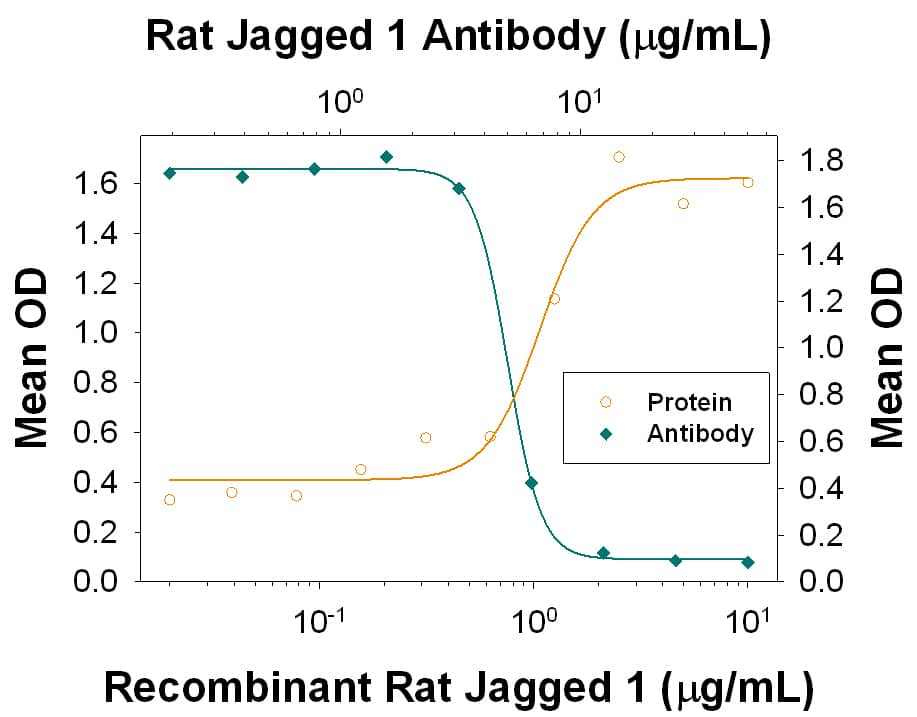Rat Jagged 1 Antibody
R&D Systems, part of Bio-Techne | Catalog # AF599


Key Product Details
Species Reactivity
Validated:
Cited:
Applications
Validated:
Cited:
Label
Antibody Source
Product Specifications
Immunogen
Ser32-Asp1068 (Gly57-Arg59 del, Asp63Thr, Arg64Leu, and Val-Arg-Pro-Tyr ins before Lys69)
Accession # Q63722
Specificity
Clonality
Host
Isotype
Endotoxin Level
Scientific Data Images for Rat Jagged 1 Antibody
Differentiation Induced by Jagged 1 and Neutralization by Rat Jagged 1 Antibody.
Recombinant Rat Jagged 1 Fc Chimera (Catalog # 599-JG) induces differentiation in the C3H10T1/2 mouse embryonic fibroblast cell line in the presence of Recombinant Human BMP-2 (Catalog # 355-BM) in a dose-dependent manner (orange line), as measured by alkaline phosphatase activity. Differentiation elicited by Recombinant Rat Jagged 1 Fc Chimera (3 µg/mL) in the presence of Recombinant Human BMP-2 (150 ng/mL) is neutralized (green line) by increasing concentrations of Goat Anti-Rat Jagged 1 Antigen Affinity-purified Polyclonal Antibody (Catalog # AF599). The ND50 is typically 3-15 µg/mL.Applications for Rat Jagged 1 Antibody
CyTOF-ready
Flow Cytometry
Sample: Rat cortical stem cells
Western Blot
Sample: Recombinant Rat Jagged 1 Fc Chimera (Catalog # 599-JG)
under non-reducing conditions only
Neutralization
Rat Jagged 1 Sandwich Immunoassay
Reviewed Applications
Read 1 review rated 5 using AF599 in the following applications:
Formulation, Preparation, and Storage
Purification
Reconstitution
Formulation
Shipping
Stability & Storage
- 12 months from date of receipt, -20 to -70 °C as supplied.
- 1 month, 2 to 8 °C under sterile conditions after reconstitution.
- 6 months, -20 to -70 °C under sterile conditions after reconstitution.
Background: Jagged 1
Rat Jagged 1 was the first ligand for Notch identified in mammals. Since both the ligands and receptors are transmembrane proteins, direct cell-cell interactions are thought to be required for activating Notch signaling. Jagged 1 is synthesized as a precursor protein that contains a 21 aa signal sequence, a 1048 aa extracellular region, a 25 aa transmembrane (TM) segment and a short, 226 aa cytoplasmic domain. The large extracellular region has a DSL (Delta, Serrate, Lag-2 consensus sequence) domain followed by 16 EGF-like repeats, and a cysteine-rich (CR) region (1). The extracellular region of rJagged 1 binds to multiple Notch receptors on the cell surface as well as in solid phase binding studies. The DSL motif is necessary for binding to Notch receptors and the EGF repeats modulate the affinity of the interaction with Notch receptors (2). Notch signaling is implicated in many developmental processes in a variety of cell types. Jagged-Notch signaling specifies cell fate, regulates pattern formation, defines boundaries between different cell types, and modulates cell proliferation and differentiation. Some specific areas where Jagged is involved include hematopoiesis, myogenesis, neurogenesis and development of the vasculature (3). For instance soluble, non-transmembrane forms of Jagged 1 influence behavior in fibroblast cells leading to characteristics exhibited by endothelial cells during angiogenesis (4). Soluble Jagged 1 is also capable of maintaining the survival and enhancing the expansion of human stem cells that are capable of reconstituting hematopoietic lineages in vivo (5). Furthermore, Jagged 1 is implicated in human disease: Alagille syndrome, an autosomal dominant disorder characterized by defects in liver, heart, eye, skeletal, craniofacial tissues, and kidney, is caused by mutations in Jagged 1 (6). Depending on cell types and how soluble forms of the ligand are presented, ligand binding can result in activation or inhibition of Notch signaling (7). Rat Jagged 1 shows 98% and 99% aa identity to human and mouse Jagged 1 extracellular domains respectively. Relative to the extracellular region of rat Jagged 2, the aa identity is 58%.
References
- Lindsell, C.E. et al. (1995) Cell 80:909.
- Shimizu, K. et al. (1999) J. Biol. Chem. 274:32961.
- Lewis, J. (1998) Stem Cell & Dev. Biol. 9:583.
- Small, D. et al. (2001) J. Biol. Chem. 276:32022.
- Karanu, F. et al. (2000) J. Exp. Med. 192:1365.
- Joutel, A. and E. Tounier-Lasserve (1998) Stem Cell & Dev. Biol. 9:619.
- Hicks, C. et al. (2002) J Neurosci. Res. 68:655.
Alternate Names
Gene Symbol
UniProt
Additional Jagged 1 Products
Product Documents for Rat Jagged 1 Antibody
Product Specific Notices for Rat Jagged 1 Antibody
For research use only